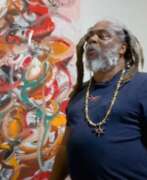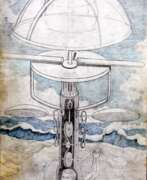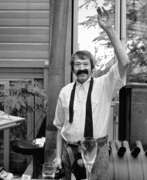Draftsmen Contemporary art




Frederico Aguilar Alcuaz is a Filipino abstract painter, sculptor and ceramist, and master tapestry artist.
He studied painting at the University of the Philippines' School of Fine Arts, then lived and worked both in the Philippines and Spain, and in Brno, Czech Republic, he worked extensively on tapestries.
Alcuaz has earned international acclaim with his vivid abstract works in various genres and techniques, and he has exhibited extensively internationally.


Harold Ambellan is an American painter and sculptor.
He studied sculpture and fine art in Buffalo before moving to New York City. The human figure is central to Harold Ambellan's work. He created monumental figures and drew extensively, leaving thousands of drawings. Ambellan was one of the participants in Roosevelt's Federal Art Project, which hired hundreds of artists during the Great Depression who collectively created more than 100,000 paintings and over 18,000 sculptures.
Ambellan remained committed to figuration in both his sculpture and painting. He was elected president of the Sculptors Guild of America in 1941, and that same year his work was exhibited in group shows at the Metropolitan Museum of Art in New York and the Academy of Fine Arts in Philadelphia.
In 1944, Ambellan participated in the liberation of Normandy as part of the U.S. Navy, then taught three-dimensional art at the Workshop School in New York City. In 1954, for political reasons, Ambellan moved to France and remained there for the rest of his life, working and exhibiting throughout Europe.


Daniel Authouart is a French painter, draughtsman and lithographer.
He studied at the École des Beaux-Arts in Rouen and lives and works in the same city. Authouart is known for his hyper-realistic paintings and lithographs on themes of modern life. He also created book bindings, posters and theater sets.


Issa Abasovich Barkhanoyev (Russian: Исса Абасович Барханоев) was a Soviet and Russian Ingush artist of the last quarter of the twentieth and early twenty-first centuries. He is known as a painter, draughtsman, landscape painter, genre painter and poet, a self-taught artist.
Issa Barkhanoyev created more than 500 paintings during his career, in which, according to critics, he skillfully conveyed his deep thoughts and feelings through images and symbols, and these works of art epitomize spirituality and life philosophy. The works of the folk artist are in museums of the Republic of Ingushetia and private collections.


Wolfram Beck was a German sculptor, draughtsman, and painter who worked with wood, steel, bronze, acrylic, and stone. He was trained at the Higher School of Artistic Culture in Berlin, and his work initially included large organic wooden works, portrait busts, and torsos in clay and stone. In the 1970s, Beck created strictly geometric and airy-filigree constructions from mechanical and electronic components that could be moved by actuators or by hand. He also created colorfully accented and fragile looking objects in metal and acrylic. Beck's work can be found in the collections of Axel Springer, Egon Eiermann, and others.


Thomas Bernstein is a German visual artist and art teacher. From 1978 to 1985 he studied at the Düsseldorf Art Academy. In addition to figurative works on paper, the sculptor, draftsman and performer also creates anthropomorphic sculptures from various materials, primarily silicone. The dominant theme in his performances is movement, the everyday and the absurd. While his pictorial works relate to questions of human communication, he shows abstract body-related forms in his sculptures. These can be found in his figurative drawings in a more naturalistic way.


McArthur Binion is an American artist based in Chicago, Illinois.
McArthur Binion's work primarily consists of minimalist abstract paintings, created using crayons, oil stick, and ink, often on rigid surfaces such as wood or aluminum. For many years, Binion has been incorporating laser-prints as a collaged ground on top of which he applies other mediums.


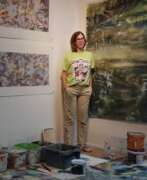

Claudia Bormann is a German artist known for her stunning water landscapes. She lives and works in Ratzeburg, Schleswig-Holstein.
Claudia Bormann crosses the boundary between photography and painting, and between reproduction of nature and abstraction. In her paintings she approximates the natural motif and at the same time distances herself from reality. Her artworks are modern in the best sense of the word, but at the same time imbued with a deep romanticism that believes in the magic of place.


Mark Boyle is a Scottish media artist from the British underground.
Since 1985 he and his wife Joan Hills and their children Sebastian and Georgia formed a collaborative art group called The Boyle Family. The Boyle family experimented with different techniques and styles. This included performances and events, films and projections, sound recordings, photography, electronic micro-photography, drawing, assemblage, painting, sculpture and installation.
However, their most famous long-term project remains Journey to the Earth's Surface, which they began in 1964 and which is a continuum of strange and interesting works. These paintings-very precise drawn casts, something in between painting and sculpture-are careful recreations of randomly selected sections of the earth's surface using resin and fiberglass, as well as real materials collected from the site under investigation.


Raymond Redvers Briggs was a British writer, illustrator, and cartoonist.
A professional illustrator, he worked on the design of children's books. In the 1960s, Briggs discovered his talent and ability to combine words and pictures, using a form of strip cartooning that defined his later work.
Briggs is best known for his wordless book The Snowman, published in 1978, a sort of cute children's tale but with deep meaning. The animated and musical versions of this book are popular in Britain and are shown annually at Christmas.


Guillaume Bruère is a French painter, drawer, sculptor and performer. He lives and works in Berlin.
Guillaume Bruère graduated from the Ecole des Beaux-Arts de Nantes (DNSEP) in 1999, then from the Ecole Européenne Supérieure de l'Image in Poitiers in 2003.
Fascinated by the major artists of art history (Holbein, Dürer, Rembrandt, Goya, Van Gogh, Giacometti, Picasso, Bacon), Guillaume Bruère has been working since 2009 in many museums and prestigious institutions (e.g. Kunsthaus Zürich, Musée Picasso Paris, Fondation Vincent Van Gogh Arles) to reinterpret their works, notably through drawing.
From his confrontation with the art of the past (Egyptian, Greek, Mexican, heraldic art, etc.), a singular, dense universe of extraordinary vitality emerges through the use of colour, the expressiveness of his gesture, the sureness of his line, and collage, which can be found in many of his drawings, but also in his painting, sculpture and performances.
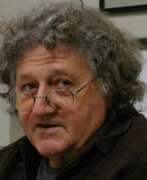

Bruno Bruni senior is an Italian lithographer, graphic artist, painter and sculptor. He became commercially successful in the 1970s. In 1977, he won the International Senefeld award for Lithography. He has since become one of the most successful Italian artists in Germany and one of Germany's best known lithographers.


Roger Capron, birth name Roger Henri Louis Capron, is a French ceramic sculptor and draftsman.
Capron studied applied arts in Paris and in 1946 founded a pottery workshop, l'Atelier Callis, in Vallauris, employing up to 120 people at various times. Capron won many awards, including the Grand Prix International de la Céramique in 1970, and in 1983 he founded the now famous Atelier Capron.
Roger Capron's creations often use clay tiles or enameled lava tiles, traditionally used for decorative panels. This recognizable way of using ceramics in furniture and objects has become the designer's trademark. Capron was the first to put his ceramic expertise at the service of semi-industrial production. The workshop developed into a small factory and gained an international reputation.


Fabrizio Clerici was an Italian painter, draftsman, illustrator, scenographer and architect.
Clerici earned a degree in architecture and was greatly influenced by antiquities, Renaissance and Baroque painting and architecture. In 1943, Clerici held his first solo exhibition at the Galleria dell'Arte Cairola in Milan, featuring drawings, watercolors, lithographs and etchings. His first book illustrations belong to the same period.
In 1947, Clerici began a prolific career in theater, ballet and opera with his debut as a stage designer in a production of George Bernard Shaw's play Mrs. Warren's Profession. The following year he participated for the first time in the Venice Biennale. There he met Salvador Dalí and created the sets and costumes for Igor Stravinsky's Orpheus, which was performed at the La Fenice Theater. In 1949 he created large-scale architectural fantasy paintings.
The further life of the multifaceted artist Fabrizio Clerici was full of work in a variety of fields of art, creative successes and exhibitions. His work has been exhibited in many museums in the United States, including MoMA and the Guggenheim Museum, as well as in France, such as the Pompidou Center.




William Glen Crooks, an American neorealist painter, has carved a niche for himself with his unique approach to landscape and urban scene painting. Unlike traditional representations, Crooks' works omit human figures, substituting them with vehicles to embody human traits and emotions. His approach to capturing the essence of city and small-town life through this lens has garnered attention for its depth and thoughtfulness. William Glen Crooks' dedication to his craft began at a young age, evolving from drawing comics to a self-taught mastery in representational painting, driven by a passion to defy the norms of modernism that dominated his formative years. His self-imposed rigorous practice of drawing laid the foundation for his distinctive style.
William Glen Crooks' work has been the subject of several exhibitions, including a notable showcase at the Oceanside Museum of Art (OMA). The exhibition, "The Point of View," marked his first museum exhibition and featured twenty-three paintings that spanned over twenty-five years. These works emphasize cityscapes, nostalgic urban scenery, and expansive landscapes, illustrating Crooks' ability to translate everyday scenes into compelling narratives. His paintings are celebrated for their illumination of light and shadow, transforming landscapes into metaphors that reflect his perceptions of the natural world.
His technique and subject matter draw inspiration from a blend of influences, including the landscape painters of the 1800s, Edward Hopper's narrative style, Mark Rothko's color fields, Wolf Kahn's liberating techniques, and John Frederick Kensett's luminism. This eclectic mix has allowed William Glen Crooks to explore the opacity of light and transparency of shadow in a way that brings a fresh perspective to the landscape genre, making his work resonate with a contemporary audience while retaining a timeless quality.
For collectors and experts in art and antiques, William Glen Crooks offers a unique investment in the realm of contemporary realism. His paintings invite viewers to explore the subtle interplay of light, shadow, and form, capturing the quiet moments of daily life with a profound depth and sensitivity.
To stay updated on William Glen Crooks' latest works and exhibitions, signing up for newsletters from galleries and museums that feature his work, such as the Oceanside Museum of Art, is recommended. This subscription will ensure that enthusiasts are always informed about new sales, auction events, and showcases related to Crooks' evolving portfolio.


José de Guimarães, real name José Maria Fernandes Marques, is a contemporary Portuguese artist, a unique and inimitable figure in contemporary art. His training as an engineer, his approach as an anthropologist, his passion as a collector and his eye as an artist have for sixty years merged and intertwined to create a graphic and richly coloured language.




Lin Felton, known as QUIK, is an American graffiti artist living and working in Brooklyn, New York.
At the age of ten, he was already painting on subway trains, marking the "Star 10" as he called himself at first. Two years later, he took the pseudonym QUIK, under which he later became internationally known. In the early 1980s, he was attending PRATT Institute and Parsons School of Design when he was discovered by a prominent Dutch art dealer.
Felton has developed recognizable satirical comic imagery that he extends far beyond simple taglines, introducing both social and personal issues into his paintings. The theme of racial inequality in American society became prevalent in his work, combined with cynical juxtapositions of popular cartoon characters, pin-up girls, and writing on walls.
Although today Felton's work can be seen in numerous galleries and museums in the United States, Japan, Europe and Hong Kong, his real passion remained on walls and on trains, which even landed him in jail several times.


Giuseppe Fortunato is a versatile Italian artist, sculptor, designer, and draftsman. At the end of the 1980s he created, together with other artists, the Images movement. Fortunato's famous paintings were created in the technique of collage with enamel on canvas, and elements of surrealism and metaphysical painting can be traced in his work.


Alfred Fritzsching is a German artist known as Painter, graphic artist, draftsman, sculptor, commercial, commercial graphic artist. He began his training as a commercial graphic artist at the Blocherer School for Graphic and Advertising in Munich and worked as an advertising specialist. In 1970 Alfred Fritzsching became a member of Munich Artists 'cooperative and participated in exhibitions at the Haus der Kunst in Munich. From 1978, he worked as a freelance painter and also as board member and juror of the Munich Artists' Cooperative.


Ernst Fuchs was an Austrian painter, draftsman, printmaker, sculptor, architect, stage designer, composer, poet, and one of the founders of the Vienna School of Fantastic Realism. In 1972, he acquired the derelict Otto Wagner Villa in Hütteldorf, which he restored and transformed. The villa was inaugurated as the Ernst Fuchs Museum in 1988.


Stephan Geisler is a German painter and draftsman who has exhibited his works nationally, as well as in Azerbaijan, Denmark, the United Arab Emirates, South Korea, the United States, the United Kingdom, and Spain. His artistic practice centers around the search for intensity. For Geisler, intensity is expressed through the inspiration, emotion, and empathy of an encounter. In his creative process, he also engages in a dialogue with the resulting imagery, continuously exploring and questioning every step.


Fritz Genkinger is a German artist, member of the German Association of Artists.
He participated in the 1972 Munich Olympics as a draughtsman and designed the posters for the World Championships.
A versatile creator, Genkinger was, among other things, fascinated by Bettingen marble, from which he even carved clear-sounding stone flutes.
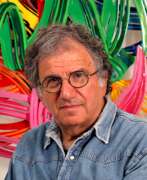

David (Dudu) Gerstein is an Israeli painter, sculptor, draftsman and printmaker.
Gerstein received a broad education: he studied at the Bezalel Academy, then at the École des Beaux-Arts in Paris, in New York he continued his studies at the Art Students League, and in 1974 he received a diploma from St. Martin's School of Art in London. He works freely in all media: printmaking, painting, sculpture, drawing, murals and monumental creations.
In the 1970's Gerstein began experimenting with three-dimensional works, leaving cut-out fragments hanging in space. After many innovations, David began creating wall sculptures made with laser cutting and automotive paint. He created his own kind of pop art and gained an international reputation for his signature style with colorful images of numerous cyclists, butterflies, dancers, runners and more. With the advent of computers, he was able to convert his drawings into perfectly formatted patterns that can be faithfully reproduced in a metalworking shop.
And Gerstein's recognizable monumental sculptures can be seen in cities around the world. His street sculpture Momentum is Singapore's tallest public sculpture.


Rolf Gith is a German painter, draughtsman and designer. He studied painting at the University of Fine Arts in Hamburg. He was involved in teaching at various institutions of higher education. Git is a member of the Association of German Artists.
Rolf Git worked in different genres: he was fond of nudes, painted portraits of the people around him as well as numerous self-portraits. Since 1996 colour and light have been central themes in his work.


Herman Moiseyevich Gold (Russian: Герман Моисеевич Гольд) is a Soviet, Ukrainian and contemporary Israeli artist. He is known as a painter, draftsman, and watercolorist, renowned for his expressive style of painting.
Herman Gold is skilled in both oil painting and watercolor, and often gives his works a dramatic character. He is one of the few contemporary Jewish artists to be included in the legendary World Encyclopedia of Artists of All Time.
His works are in museums and galleries in many countries, including Russia, Ukraine, France, Greece, the United States and others.


Rachel Goodyear is an English painter-drawer and sculptor who works in the dark fantasy genre. She is known for her dark humor, fantastical subjects with corpses, masks, animals, etc. Creating her paintings and collages, the artist uses watercolor, gold leaf on paper, and produces porcelain sculptures.


Arthur Floyd Gottfredson was an American cartoonist best known for his defining work on the Mickey Mouse comic strip, which he worked on from 1930 until his retirement in 1975. His contribution to Mickey Mouse comics is comparable to Carl Barks's on the Donald Duck comics. 17 years after his death, his memory was honored with the Disney Legends award in 2003 and induction into the Comic Book Hall of Fame in 2006.


Emilio Greco was an Italian realist sculptor, draftsman, writer and poet.
At the age of 13, Greco was apprenticed to a mason and later studied at the Academy of Fine Arts in Palermo. His first solo exhibition took place in 1946. Emilio Greco created monumental figurative works in bronze and marble, park sculptures, primarily nude female figures and portraits. His sculptures are characterized by refined, elongated forms in the tradition of Italian mannerism. Notable among them is the monument to the character Pinocchio (Pinocchio and the Fairy) for the town of Collodi.
Greco also designed one of the bronze doors of the cathedral in Orvieto and the monument to Pope John XXIII in St. Peter's Basilica. In 1974, a Greco Garden dedicated to his works was opened at the Open Air Museum in Hakone, Japan.


Friederike Groß is a German painter, caricaturist and university teacher who lives and works as a freelance artist in Stuttgart.
Friederike Groß studied free graphics and art education with Dieter Groß at the State Academy of Fine Arts Stuttgart from 1984 to 1989. Since 1985, Friederike Groß has worked as a caricaturist for the Stuttgarter Zeitung.
From 2008 to 2014, Friederike Groß taught as a lecturer in drawing at the Swiss Federal Institute of Technology (ETH) in Zurich. Since 2013, she has held a professorship for illustration at the Berlin Technical University of the Arts (BTK) at the campus in Hamburg.


Mariann Grunder, or Susie Mariann Grunder, was a Swiss artist and sculptor. She created large wall reliefs with concrete elements. And her stone sculptures, which often deal with literary or mythological themes, combine elements of surrealism, abstraction and minimalism. Grunder has also done numerous drawings and prints.


Albert Guillaume was a French artist, cartoonist, illustrator, and master of the poster.
Guillaume was a prolific illustrator: he worked for magazines, books, and almanacs, and his satirical drawings were published in Parisian humor magazines. He was also a painter and designer of theater posters and advertising posters. Working for the large Parisian printing company Camis, he designed a series of highly successful posters for commercial goods.


Erwin Heerich was a German artist.
Heerich emphasized that for him, "cardboard, like polystyrene, had no specifically aesthetic or historical connotations, the materials are value-neutral to the largest possible extent." Furthermore, the artist was not primarily "concerned with the manifestation of an art object, but with making an idea material in terms of a specific problem: how space can be presented and formed."


Susan Hefuna is a German-Egyptian artist working in various fields of art.
She was born from the union of an Egyptian and a German, which put her at the intersection of the two cultures in which she was immersed. Hefuna completed her PhD in multimedia at the Institute for New Media in Frankfurt. She lives between Egypt and Germany and works in a variety of media including drawing, photography, sculpture, installation, video and performance. Hefuna combines her Egyptian and German roots in her work, using urban imagery, typography and traditions from both to build a bridge between the two cultures.
Hefuna's work often incorporates the form or image of the characteristic mashrabiya, an oriental carved wooden or stone architectural lattice screen.


Roni Horn is an American visual artist and writer. The granddaughter of Eastern European immigrants, she was born in New York City, where she lives and works. She is currently represented by Xavier Hufkens in Brussels and Hauser & Wirth.
Horn has been intimately involved with the singular geography, geology, climate and culture of Iceland.


Rolf Iseli is a Swiss avant-garde artist living and working in Bern.
At the beginning of his artistic career, Iseli was a radical representative of Taschism and the Informel movement, and also painted in gesture technique. During his long life he has worked in different fields: painting, collage, drawing, lithography, drawing, plastic art, sculpture and art in architecture. Rolf Iseli is one of the most important representatives of the Swiss artistic avant-garde of the second half of the 20th century.
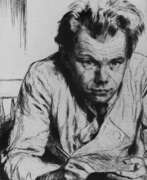

Hermann Kätelhön was a German artist of the first half of the twentieth century. He is known as a realist painter, graphic artist, woodcarver and ceramicist.
Kätelhön created works depicting the people and nature of middle Germany, including portraits of peasants and sketches of fieldwork scenes. His graphic series "Work" as well as his drawings on the theme "Mining Leaders" explore the labor of miners. The artist later turned to depicting nature, especially water, including springs, rivers, glaciers, and seas.


Herma Körding is a German painter and drawer.
She studied painting at the National Academy of Fine Arts in Karlsruhe, then in Paris at the École Nationale Supérieure des Beaux-Arts and the Académie Joulian, and also attended the Düsseldorf Academy of Art. Herma Körding fought for the right of women artists to have their own exhibition spaces and for many years was the only female member of the "Malkasten" association of artists. Herma Körding painted still lifes, landscapes and portraits.
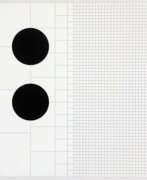

Attila Kovács is a Hungarian-German graphic artist.
He studied at the Hungarian Academy of Fine Arts, emigrated to West Germany and graduated from the State Academy of Fine Arts in Stuttgart.
Kovacs created a unique artistic language he called "Frame of Reference" or "Transmuting Plasticity," in which he constructed his own system of non-Euclidean sequential geometric abstraction. Kovacs has had many international solo and group exhibitions.


Michael Lesehr is a German painter and draftsman who lives and works in a studio in Stuttgart.
He was taught to paint with both hands by his father, the sculptor Georg Lesehr, and studied painting at the State Academy of Fine Arts in Stuttgart, among others.


Lena Lešková-Bubánová is a Slovak artist, graphic artist, draftsman and textile artist.
She graduated from the Prešov University of Applied Sciences, lives and works in Košice, and works in drawing, painting and graphic arts. Lešková-Bubánová has exhibited in the USA, Japan, Switzerland, Germany, Italy, Poland, Hungary and many other countries. In 1977, she received the main prize - the Gold Prize in the category of design at the prestigious Kutani International Decorative Ceramics Exhibition in Japan.
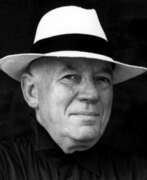

Horst Linn is a German sculptor and draftsman, teacher, living and working in Dortmund, Germany.
Horst was born into the family of sculptor Willi Linn and received his primary art education from his father. From 1956 Horst Linn studied at the Saarbrücken State School of Arts and Crafts and gradually honed his skills in different techniques.
Horst Linn's works are usually laconic, but the oblique folds of the sculptor's work obey the strict laws of constructivism. Whether it is the early folds of corrugated sheet iron or the later wall reliefs of folded aluminum steel or sheet metal, usually lacquered, all of his works are based on the principle of "less is more." As a spatial artist, he places works in urban, public and private spaces.


Roger Loewig was a German artist, illustrator and writer.
In addition to working as a teacher of Russian, German and history, Loewig independently practiced painting and drawing. In 1963, he organized an exhibition of his work, but was arrested on charges of "incitement endangering the state". Most of his paintings and literary texts were confiscated.
In 1972, he left for the Federal Republic of Germany, where he found recognition for his talent. Along with Günter Grass, Christoph Meckel and others, he joined the wide circle of "Berlin poets-artists", and Loewig's visual art became recognized as fantastic realism. Loewig's artworks and texts about war, flight, exile, and unfreedom placed him among the most important German artists of the postwar period.


Birgit Megerle is a German artist who lives and works in Berlin.
She was educated at the Hamburg University of Fine Arts and her work includes painting, drawing, collage and performance art.
The motifs in Megerle's work are contemporary, relevant and yet devoid of an obvious time period or identifiable context. The images are subtly voyeuristic.
































































